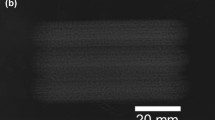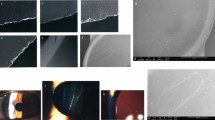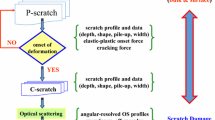Abstract
Lenses and other transparent optical materials suffer rapid damage when subjected to blowing abrasive particulates. The time-scale of these impact event falls between typical scratch tests (less than 1m/s) and ballistic tests (100s of m/s) and has not been studied in depth to date. Polymeric lens materials like polycarbonate are usually treated with a scratch-resistant coating, which is commonly silica-based. The coating provides some protection, yet is not sufficient at resisting abrasion from blown sand in most commercial products. We demonstrate that silicone elastomeric coatings are superior to polycarbonate and silica glass at resisting damage by blown sand particles. Sand abrasion tests were conducted using a custom-built test apparatus that exposes the sample to 400 micron diameter quartz silica moving at 16.5 m/s (approx. 38 mph). Scanning electron microscopy revealed the presence of small cracks and pits in polycarbonate, coated polycarbonate, and silica glass after sand exposure. No such damage was observed in the silicone-coated samples after an identical exposure.
We speculate that the elastic tensile strain at the surface is an important predictor of the material response at the time-scale of the impact. A simple mathematical model was developed using a momentum balance pre- and post-impact, and was used to approximate the maximum deformation and impact time-scale. A semispherical interaction volume was used in the model with a radius of 1.5x the particle diameter, determined through profilometry experiments. The material’s resistance to deformation was measured experimentally through a static mechanical test using a spherical indenter to represent the particle. Tensile tests were performed on both materials to identify the maximum elastic strain.Additionally, dynamic mechanical tests were performed to confirm that the mechanical behavior at long time-scales was valid at shorter time-scales of the impacts. DMA curves were shifted using the WLF equation. Profilometry and scanning electron microscopy (SEM) imaging were used to confirm the presence or absence of blown-sand induced damage.
Similar content being viewed by others
References
Weidian Shen ; Lan Mi ; Bin Jiang .“Characterization of mar/scratch resistance of coatings with a Nano-indenter and a scanning probe microscope” Tribology International 1–13 (2005).
Vincent Jardret ; Pierre Morel .“Viscoelastic effects on the scratch resistance of polymers: relationship between mechanical properties and scratch properties at various temperatures” Progress in Organic Coatings. 48, 322–331 (2003).10.1016/j.porgcoat.2003.02.002
M. Wong ; G.T. Lim ; A. Moyse ; J.N. Reddy ; H.J. Sue“A new test method for evaluating scratch resistance of polymers” Wear 256, 1214–1227 (2004)10.1016/j.wear.2003.10.027
J.A. Brydson Plastic Materials, Seventh Edition. Butterworth-Heinemann, Woburn, MA, 1999.
W.J. Stronge Impact Mechanics. Cambridge University Press, Cambridge, UK, 2000.10.1017/CBO9780511626432
S.F. Sun Physical Chemistry of Macromolecules. John Wiley & Sons, Inc., New York, NY, 1994.
Author information
Authors and Affiliations
Rights and permissions
About this article
Cite this article
Drew, C., Bosselman, S. & Ziegler, D. Optical Coating Properties for Enhanced Blown-Sand Abrasion Resistance. MRS Online Proceedings Library 977, 425 (2006). https://doi.org/10.1557/PROC-977-0977-FF04-25
Received:
Accepted:
Published:
DOI: https://doi.org/10.1557/PROC-977-0977-FF04-25




